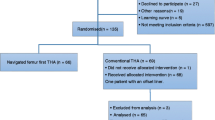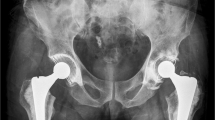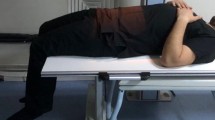Abstract
The acetabular cup position after total hip arthroplasty (THA) regarding its inclination and version angles are influential parameters concerning the postoperative range of motion and dislocation stability. Standard anterior-posterior X-rays remain an important diagnostic instrument to observe the postoperative outcome and to secure quality control after THA, where an optimal positioning of the patient is recommended when taking these X-rays. The purpose of this preliminary study was to determine the effect of pelvic tilting regarding the positioning calculation of the acetabular cup from standard radiographs using a modified method according to Pettersson et al. (Acta Radiol Diagn, 23:259–263, 1982). In our model experiment, we were able to show that pelvic tilting to either side causes a considerable difference between the radiographic and calculated version angles following approximately linear functions. However, pelvic tilting to either side, leads, regarding the calculation of the inclination, to an average deviation between radiographic and calculated inclination angles less than 2°.







Similar content being viewed by others
Notes
D1 und d1 are equivalent, respectively, to the long and the short diameter of the ellipse of the acetabular cup with a symphysis centered X-ray beam, D2 and d2 are equivalent, respectively, to the long and the short diameter of the ellipse of the acetabular cup with a hip-centered X-ray beam.
Equals the sum of radiographic anteversion and the responding pelvic tilting.
References
Ackland MK, Bourne WB, Uhthoff HK (1986) Anteversion of the acetabular cup—Measurement of angle after total hip replacement. J Bone Joint Surg 86B:409–413
Aubry S, Marinescu A, Forterre O et al (2005) Definition of a reproducible method for acetabular anteversion measurement at CT. J Radiol 86:399–404
Bader R, Barbano R, Wörtler K et al (2004) Positionsbestimmung an der künstlichen Hüftpfanne mittels Standard-Röntgenaufnahmen: Einfluss der Beckenkippung. Orthopädische Praxis, Sonderausgabe 2004:242–243
Bader R, Steinhauser E, Scholz R et al (2004) Experimentelle Analyse von neutralen, asymmetrischen und Schnapp-Pfannen für die Hüftendoprothetik: Untersuchungen zur Range of Motion und Luxationssicherheit. Z Orthop 142:577–585
Eddine TA, Migaud H, Chantelot C et al (2001) Variations of pelvic anteversion in lying and standing positions: analysis of 24 control subjects and implications for CT measurement of position of prosthetic cup. Surg Radiol Anat 23:105–110
Haenle M, Mittelmeier W, Barbano R et al (2006) Intra- und Interobserver-Reliabilität verschiedener Methoden zur Positionsbestimmung künstlicher Hüftpfannen. Orthopädische Praxis, Sonderausgabe 2004:233
Hassan DM, Johnston GHF, Dust WNC et al (1995) Radiographic calculation of the anteversion in acetabular prostheses. Arthroplasty 10:369–372
Hedlundh U, Hybbinette CH, Fredin H et al (1995) Dislocations and the femoral head size in primary total hip arthroplasty. Clin Orthop 333:226–233
Jamaraz B, Nikou C, Simon DA et al (1997) Range of motion after total hip arthroplasty: experimental verification of the analytical simulator. Tech Rep CMU-RI-TR-97-09, Robotics Institute, Carnegie Mellon University, February 1997
Kalteis T, Handel M, Herold T et al (2006) Position of the acetabular cup—accuracy of radiographic calculation compared to CT-based measurement. Eur J Radiol 58:294–300
Kummer FJ, Shah S, Iyer S et al (1999) The effect of acetabular cup orientations on limiting hip rotation. J Arthroplasty 14:509–513
Lazennec JY, Ramare S, Arafati N et al (2000) Sagittal alignment in lumbosacral fusion: relations between radiological parameters and pain. Eur Spine J 9:47–55
Lazennec JY, Charlot N, Gorin M et al (2004) Hip–spine relationship: a radio-anatomical study for optimization in acetabular cup positioning. Surg Radiol Anat 26:136–144
Lembeck B, Mueller O, Reize P et al (2004) Einfluss der Beckenkippung auf die radiologischen Messungen von Implantationswinkeln der Hüftpfanne. Z Orthop 141:S64
Müller O, Lembeck B, Reize P et al (2005) Quantifizierung und Visualisierung des Einflusses der Beckenkippung auf die Messung von Pfanneninklination und -anteversion. Z Orthop 143:72–78
Murray DW (1993) The definition and measurement of acetabular orientation. J Bone Joint Surg 75B:228–232
Nikou C, Jaramaz B, DiGioia AM et al (2000) Description of anatomic coordinate systems and rationale for use in an image-guided total hip replacement system. Lecture Notes Comput Sci 1935:1188–1194
Nishihara S, Sugano N, Nishii T et al (2003) Measurements of pelvic flexion angle using three dimensional computed tomography. Clin Orthop 411:140–151
Olivecrona H, Weidenhielm L, Olivecrona L et al (2004) A new CT method for measuring cup orientation after total hip arthroplasty: a study of 10 patients. Acta Orthop Scand 75:252–260
Pettersson H, Gentz CF, Lindberg HO et al (1982) Radiologic evaluation of the position of the acetabular component of the total hip prosthesis. Acta Radiol Diagn 23:259–263
Pradhan R (1999) Planar anteversion of the acetabular cup as determined from plain anteroposterior radiographs. J Bone Joint Surg 81B:431–435
Tannast M, Murphy S, Langlotz F et al (2006) Estimation of pelvic tilt on anteroposterior X-rays—a comparison of six parameter. Skeletal Radiol 35:149–155
Widmer KH (2004) A simplified method to determine acetabular cup anteversion from plain radiographs. J Arthroplasty 19:387–390
Wolf A, Digioia AM 3rd, Mor AB et al (2005) A kinematic model for calculating cup alignment error during total hip arthroplasty. J Biomech 11:2257–2265
Zilber S, Lazennec J-Y, Gorin M et al (2004) Variations of the caudal, central and cranial acetabular anteversion according to the tilt of the pelvis. Surg Radiol Anat 26:456–462
Author information
Authors and Affiliations
Corresponding author
Rights and permissions
About this article
Cite this article
Haenle, M., Heitner, A., Mittelmeier, W. et al. Assessment of cup position from plain radiographs: impact of pelvic tilting. Surg Radiol Anat 29, 29–35 (2007). https://doi.org/10.1007/s00276-006-0167-z
Received:
Accepted:
Published:
Issue Date:
DOI: https://doi.org/10.1007/s00276-006-0167-z




